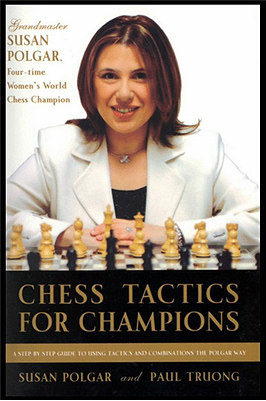Chess Tactics for Champions, by GM Susan Polgar and Paul Truong
I've had some changes in my life lately and more are coming so I took a break from chess, but I found a bit of time to finish this chess puzzle book that I started reading a few months ago, but never quite got around to complete. Chess Tactics for Champions is not really for champions, but for beginner to intermediate level, or at least this is what it felt like to me. Susan Polgar chose to structure the book into chapters of about 25 puzzles or examples, each covering some important aspect of chess tactics. Here is a list of those chapters:
The last two chapters are presentational only, but the first 20 contain puzzles that the reader must solve, with solutions at the end of the chapter. The authors tried to order the chapters by complexity, so that beginners could understand and solve the first chapters and then move over to the more advanced positions, but it is not always so. It seemed to me that, for most of the chapters, the last two puzzles are especially chosen for the "wow!" factor.
The bottom line is that the book is not just something you read. You solve the puzzles, some are frustrating, some are beautiful, most can be "seen" without a board in front of you - for the last chapter I would advise a board, though - but one can return to this book again and again. For example myself, once I get around to chess again, I might go through the book, just to get into the solving mindset that is essential to beautiful play. Now, I don't know how other chess puzzle books are, this being my second chess book I have read, but I imagine some could be a lot better. However, the structure of Chess Tactics for Champions makes it very easy to use as a reference book. One thing I felt was missing was pawn play. Of course, that often enters the category of strategic play, rather than tactic, but still.
More about the authors at Wikipedia: Susan Polgar and Paul Truong. They have been married since 2006.

- 01 - Forks and double attacks
- 02 - Pins
- 03 - Deflection/removing the guard
- 04 - Discoveries
- 05 - Double check
- 06 - Skewers
- 07 - Trapping pieces
- 08 - Decoys
- 09 - Intermediate moves
- 10 - Pawn promotion
- 11 - The back-rank problem
- 12 - Destroying the castled king's protection
- 13 - King chase
- 14 - Mixed checkmates in two moves
- 15 - Mixed checkmates in three moves
- 16 - Mixed checkmates in four moves
- 17 - Game-saving combinations
- 18 - Perpetual check
- 19 - Stalemate
- 20 - Traps and counter traps
- 21 - Sibling positions
- 22 - Twenty-five famous combinations
The last two chapters are presentational only, but the first 20 contain puzzles that the reader must solve, with solutions at the end of the chapter. The authors tried to order the chapters by complexity, so that beginners could understand and solve the first chapters and then move over to the more advanced positions, but it is not always so. It seemed to me that, for most of the chapters, the last two puzzles are especially chosen for the "wow!" factor.
The bottom line is that the book is not just something you read. You solve the puzzles, some are frustrating, some are beautiful, most can be "seen" without a board in front of you - for the last chapter I would advise a board, though - but one can return to this book again and again. For example myself, once I get around to chess again, I might go through the book, just to get into the solving mindset that is essential to beautiful play. Now, I don't know how other chess puzzle books are, this being my second chess book I have read, but I imagine some could be a lot better. However, the structure of Chess Tactics for Champions makes it very easy to use as a reference book. One thing I felt was missing was pawn play. Of course, that often enters the category of strategic play, rather than tactic, but still.
More about the authors at Wikipedia: Susan Polgar and Paul Truong. They have been married since 2006.
Comments
Be the first to post a comment